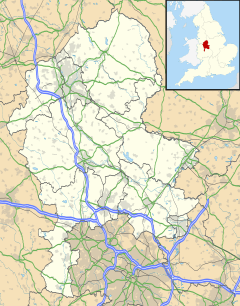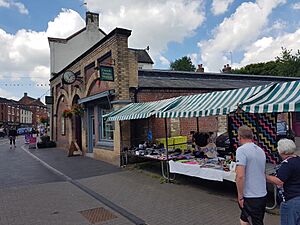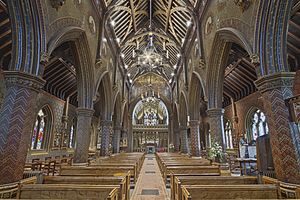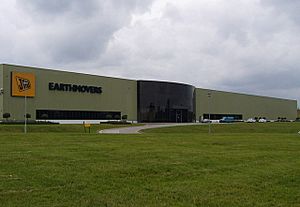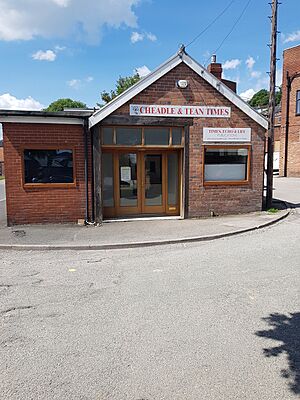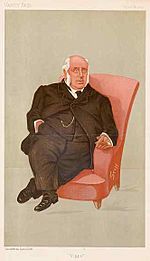Cheadle, Staffordshire facts for kids
Quick facts for kids Cheadle |
|
|---|---|
 St Giles' Catholic Church |
|
| Population | 12,165 (2011) |
| OS grid reference | SK010431 |
| District |
|
| Shire county | |
| Region | |
| Country | England |
| Sovereign state | United Kingdom |
| Post town | Stoke-on-Trent |
| Postcode district | ST10 |
| Dialling code | 01538 |
| Police | Staffordshire |
| Fire | Staffordshire |
| Ambulance | West Midlands |
| EU Parliament | West Midlands |
| UK Parliament |
|
Cheadle is a busy market town in Staffordshire, England. It's located in the Staffordshire Moorlands area. In 2021, about 12,000 people lived here. Cheadle is found between other towns like Uttoxeter, Leek, Ashbourne, and Stoke-on-Trent.
This town has a long history, going all the way back to Anglo-Saxon times. It's a great place to explore, with interesting buildings and beautiful countryside nearby.
Contents
What's in a Name?
Cheadle's name first appeared in a very old book called the Domesday Book in 1086. Back then, it was called Celle or Cedla.
The first part of the name comes from an old British word meaning "woodland." Later, when Old English became common, people added a word meaning "clearing in woodland." So, Cheadle likely means "cleared land in the woods."
A Look Back in Time
Cheadle is mentioned in the Domesday Book as a small place with only nine families. In 1176, the Basset family took over the area. In 1250, King Henry III gave them permission to hold a market and a yearly fair in Cheadle.
By 1309, about 75 families were using a mill to grind corn near Mill Road. Around 50 years later, a new church was built. This church replaced an even older one from the 1100s.
In 1606, a school was started by the church. Later, in 1685, a local church leader, Rev. Henry Stubbs, left money to start a grammar school. This school was built behind the High Street and taught students until 1917. The money from Rev. Stubbs still helps local education today.
By 1676, Cheadle had just over 1,000 people. A hundred years later, in 1772, the population grew to 1,800. Most people worked in farming back then.
In 1798, ten houses were built for weavers. These people made tape using looms upstairs in their homes. By the 1820s, the looms moved to a factory on Tape Street. This factory closed in 1972 and is now a shop. In 1851, factories for silk and other fabrics opened, employing hundreds of people. They closed in 1981.
In 1725, a company started making brass and copper in Cheadle. This company later moved and was bought by Thomas Bolton in 1851. Bolton's opened another factory in 1890, and the older works closed in 1963.
St Giles' Catholic Church opened in 1846. Its tall spire, about 60 meters (200 feet) high, still stands out in the town. A famous architect named Augustus Welby Northmore Pugin designed it. He was asked to make a church that was truly special. People often call it 'Pugin's Gem'.
At the start of the 1900s, Cheadle got its first outdoor swimming pools. Telephones started to be installed in 1904. In 1901, Cheadle got its own railway station. This helped industries and made it easier for people to travel. The station also helped transport sand, gravel, and coal.
The first car arrived in Cheadle in 1903. The first bus service, connecting Cheadle to Longton, began in 1914. During the Second World War, a secret listening station called RAF Cheadle helped intercept German radio messages.
Cool Places to Visit
The tall spire of St Giles' Catholic Church is a famous landmark in Cheadle. It's known as "Pugin's Gem" because it shows exactly what the architect, Pugin, believed a church should be. Everything inside has a special meaning. The church was a big part of local celebrations for Pugin's 200th birthday.
Cheadle also has an Anglican church, also named St Giles. It was rebuilt in 1837–39, but it still has parts from the older church. There's also a strong Methodist history in Cheadle. In the 1800s, Methodist chapels helped many young boys working on farms or in coal mines learn to read and write. Today, there's a large modern Methodist church in town.
South-east of Cheadle, you can find the old ruins of Croxden Abbey. This abbey was founded in 1176 by Bertram de Verdun for Cistercian monks. It's about a 5-mile walk from the town center.
Cheadle is a great starting point for exploring the Peak District National Park. This area is popular for walking and rock climbing. Cheadle is surrounded by hills and is the entrance to the wooded Churnet Valley and the Staffordshire Moorlands. It's also only about 4 miles (6 km) from the famous Alton Towers Resort.
Cecilly Brook Local Nature Reserve is close to the town center. It's an important place for water voles in Staffordshire. You can also find 42 acres of beautiful lakes at the JCB factory. For fun and sports, there's Cheadle Recreation Ground and the South Moorlands Leisure Centre.
Cheadle's High Street has many old buildings. It still looks much like it did in the Victorian era.
How Cheadle Makes a Living
In the Domesday Book, Cheadle was described as a small, unimportant village. But over hundreds of years, it grew as industries and farming developed. Historically, Cheadle relied on coal mining, silk production, farming, and making brass and copper. The town also had a textile industry, especially tape weaving. The old tape mill is now apartments.
For a long time, coal mining was the main industry in the Cheadle area. The Cheadle Coalfield was part of a much bigger coalfield. The town and nearby areas once had over sixty mines! But the industry slowly declined in the 1900s. The larger mines closed one by one, with the last big one, Foxfield, closing in 1965. However, smaller mining continued until the 1990s.
Today, the biggest employer in Cheadle is the large JCB factories. JCB makes construction equipment like diggers. There are also smaller factories where the old New Haden Colliery used to be. Many people from Cheadle also work at the nearby Alton Towers Resort. Lots of residents also travel to work in Stoke-on-Trent, Newcastle-under-Lyme, Uttoxeter, and Derby.
You can find markets in Cheadle's market place on Tuesdays, Fridays, and Saturdays.
News and Media
The Cheadle and Tean Times newspaper has been published weekly in the town since 1896. It's the only family-run, independent newspaper in North Staffordshire. Locals often call it the Stunner.
Other newspapers that cover Cheadle include the weekly Cheadle Post & Times and the daily Sentinel. For radio, you can listen to Hits Radio Staffordshire & Cheshire, Greatest Hits Radio Staffordshire & Cheshire, and BBC Radio Stoke. A community radio station called Moorlands Radio also covers the town.
Local TV news comes from BBC West Midlands and ITV Central.
Cheadle High School also runs its own internet radio station for the local area. Students at the high school produce and present the shows.
Getting Around
Cheadle used to have its own train line that opened in 1901. It took almost 30 years for local coal owners and important people in town to get the Cheadle Railway Company to build this small line and station. Even though the line was only about 6 kilometers (4 miles) long, it was hard to build. They had to dig a tunnel under a huge hill. The tunnel had problems with water and its roof.
In the 1930s, the railway company built a new line around the tunnel and stopped using it. The tunnel still exists because it was used as a coal mine in the 1970s and 80s. The southern entrance is still there, but the northern one has been filled in.
Having the train line meant that the New Haden and Parkhall coal mines could now connect to the railway network. Cheadle finally had its long-awaited train link to the outside world. The line stopped carrying passengers in 1963. It stayed open for local gravel quarries until 1982.
Today, the closest train station is Blythe Bridge.
Bus services in Cheadle are provided by different companies. First Potteries operates an hourly service (number 32) to Hanley. D&G Bus runs service 32X, also to Hanley every hour, and service E1 to Alton Towers. There's also a town service (123) by Bennetts and a service (30) to Leek by Aimee's, three times a day.
Famous People from Cheadle
- Sir Henry Samuel Wiggin (1824–1905): He was a metals manufacturer and a politician.
- William Harris (1826–1911): A politician who helped bring big changes to Birmingham.
- Mary Adela Blagg (1858–1944): An amazing astronomer. She was one of the first women allowed into the Royal Astronomical Society!
- Major Cecil Wedgwood (1863–1916): He was part of the famous Wedgwood pottery company. He was also the first mayor of Stoke-on-Trent and won an award for bravery during a war. He sadly died in 1916 during a battle.
- Edmund Crosby Quiggin (1875–1920): A British linguist and scholar who studied languages.
Sport
- Fred Obrey (1912–1986): An English footballer who played many games for Port Vale F.C..
- Fred Inskip (1924–2000): An English professional footballer who played for Crewe Alexandra F.C..
- Terry Lowe (born 1943): An English footballer who also played for Port Vale F.C..
- Bernadette Swinnerton (born 1951): A racing cyclist and a headteacher.
- Gareth Owen (born 1982): A former professional footballer. He now works as the head of the Stoke City F.C. Academy.
Schools in Cheadle
- Cheadle High School
- Painsley Catholic College
- Moorlands 6th Form College
- Bishop Rawle C.E. (Aided) Primary School
- St Giles' Roman Catholic Primary School
- Cheadle Primary School
- St Thomas' Primary Catholic School (Tean)
- Great Wood Primary School (Tean)
See also
 In Spanish: Cheadle (Staffordshire) para niños
In Spanish: Cheadle (Staffordshire) para niños


